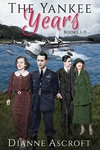I’ve just finished reading Siren of Paris by David LeRoy and it’s a story that will stay with me for a while. It has a complex, well developed plotline and presents the story in a tantalising way, jumping back and forth between 1939-40 and 1943-44. As I pondered developments in the story important elements of the plot were revealed at just the right moment. I’ve read quite a few books set during the Second World War and often find them very moving. But this one especially gripped me.
 The publisher’s blurb says: “The story starts in 1939, when Marc Tolbert, the French-born son of a prominent American family, takes off for Paris to follow his dream of becoming an artist. Marc’s life soon sparkles in the ex-pat scene in Paris. His new friend Dora introduces him to a circle that includes the famous Sylvia Beach, owner of the bookstore Shakespeare & Company; and he accepts a job with William Bullitt, US ambassador to France. At art school, he finds himself further enchanted by the alluring model Marie.
The publisher’s blurb says: “The story starts in 1939, when Marc Tolbert, the French-born son of a prominent American family, takes off for Paris to follow his dream of becoming an artist. Marc’s life soon sparkles in the ex-pat scene in Paris. His new friend Dora introduces him to a circle that includes the famous Sylvia Beach, owner of the bookstore Shakespeare & Company; and he accepts a job with William Bullitt, US ambassador to France. At art school, he finds himself further enchanted by the alluring model Marie.
Marc’s Parisian reverie, however, is soon clouded over by the increasing threat from Germany. As Americans scramble to escape Paris, he finds himself trapped by the war, and nearly meets his fate on the disastrous day of June 17, 1940, aboard the RMS Lancastria. Upon returning to Paris, his fate grows more troubled still, as he smuggles Allied airman through the American Hospital to the Paris Resistance underground, until a profound betrayal leads him into the hands of the Gestapo and onto Buchenwald.”
Although I’ve never experienced a war, the book seemed to be a realistic portrayal of wartime. Scenes of conflict and death were sometimes graphic, grim and very disturbing but this gave authenticity to the book. I think what gripped me most about it was the main character, Marc Tolbert. He is an antihero. He didn’t ask to be in the position he finds himself in and he does whatever it takes to survive. He has flaws and real, soul destroying fears. He makes me think about how I would react in the same situation and I can’t say I’d be any braver or selfless than he is. Self-preservation rather than patriotism motivate him and I think this is one of the most honest depictions of wartime that I’ve read.
In this engrossing story the author looks at people caught in a war and their reactions to it from a completely different perspective. It’s unsettling but I think it’s real and it is a good story. I would recommend it to anyone who enjoys war dramas or studies of the human psyche or just a good read.
Because I enjoyed the book so much I’ve asked David LeRoy to answer a few questions about the novel. Welcome David.
Tell us about your novel.
DL: The Siren of Paris is the story of one French born American male who runs off to Paris in 1939 to study art as a way of getting over a failed relationship back in the States. He becomes trapped by the war along with all other Americans when the Germans sink the Athenia on Sept 4th, 1939, and due to a series of circumstances he finds himself on the doomed RMS Lancastria on June 17th, 1940. After a few months, he returns to Paris for the duration of the war. He is motivated primarily out of survivor’s guilt to try and do something to make up for the fact that he survived the sinking, but his British friend died. His third return to Paris brings him betrayal that leads him to Buchenwald. In the course of this novel, my young immature American has all of his innocence burned away, transforming his consciousness.
What prompted you to write about this historical event?
DL: At first, I intended to write a remarkably brave novel about an American in the French Resistance. I was doing transportation research to try and determine just how Americans might get home from Europe after the war broke out. I stumbled upon the RMS Lancastria. The Titanic, although tragic, is also a rather romantic story. But the Lancastria is just tragic and also haunting once you read the details of the sinking. I decided to look for some way to bring the victims to life in a story. The best way appeared to be through the experience of one fictionalized survivor named Marc Tolbert.
How closely did you stick to the historical facts? If you used them loosely, how did you decide whether to deviate from them?
DL: I followed the historical facts so closely, that I even included the traveling circus that was coming down the Loire Valley as France fell to the Germans. When I do deviate from the historical record, it is to tell the story of my character Marc. For instance, Joan Rodes, the British Nurse who saved 19 men from the waters of Saint-Nazaire did lose her baby two days later. However, the relationship she has with my character and the role she plays in the story is fictionalized, but consistent with her personality during World War Two.
Overall, I tried my utmost to use real historical events in this story to give the reader the feeling of experiencing World War Two. Sometimes those facts do not synch up with our expectations. I did not know that many of the arresting agents for the Gestapo in Paris had no guns and just ran around with brief cases like traveling salesmen wearing civilian clothes. Our imagination wants to have a tall proud German in a SS Uniform with a machine gun, not a brief case full of papers.
What research did you do for this book?
DL: I read 46 books, and all of the newspapers in French up to the War, and many all through the War. I read Nazi papers and whatever French resistance papers I could find. I bought various historical items on Ebay. I did quite a bit of research on Buchenwald and the experience of returning from a concentration camp after the war. One book in that collection tells me everything I needed to know about Nazi occupied buildings in Paris.
Do you use a mixture of historic figures and invented characters in the novel. Which is more difficult to write? Which to you prefer to write and why?
DL: There is only a small handful of purely fictional characters in the book. William Bullitt, Sumner Wells, Sylvia Beach, Jacques Lusseyran, Jean, Georges, The Jackson Family, R, and the RMS. Lancastria is extremely real. Even Drew who brings Marc food is based upon a real person. In addition to the people, the traveling circus, horses, dogs and the rabbit are also real. Marie is based upon real person, who died in 1947 at the hands of another person she betrayed. And Officer Sean is based in part upon a real German from the army. Even the lovely man playing the piano at 180 Rue De La Pompe in Paris is a real person from the historical record who consequently was tried for war crimes in the 1950’s. My preference was to create a fictional character, and follow him through a not so fictional world.
In an historical novel you must vividly re-create a place and people in a bygone era. How did you bring the place and people you are writing about to life?
DL: Perhaps you are familiar with the service during Easter called Tenabrea. The altar is stripped, and all the candles are extinguished in the church, symbolizing the darkness of the valley of death as Christ approaches the Cross.
In The Siren of Paris, at the end of chapter two, I draw attention to the fact that the lights are turned out in the main dining room of the S.S. Normandie where the statue La Pax resides. For the next 41 chapters I construct the world of World War Two using small relevant details, but I am deconstructing all peace, love, joy, faith, hope, and trust in my characters’ journey. This is done to create one thing, which is the most difficult of all to recreate about World War Two, and that is the fear and dread. I push the protagonist back and forth between life and death until he is not sure of which world he resides in the most. I tear away his trust of the living and build up his trust in the ghosts of the dead. The only hope that soon remains is only in the heart of my character. The goal is to just help the reader to feel the war on an emotional level, so when Marc is hanging near the rear of the line for morning soup at a concentration camp, hoping to get some solids at the bottom, the reader knows and feels the hunger driving my character.
In addition to these small details, I drew upon Jungian Psychological images such as the butterfly, peacocks, rabbits, and the raven. Marc experiences lucid dreams during the war of people he has known who have died, and these dreams have a precognitive element to them, creating a sense of anticipation. However, aside from all the small tricks, the macro image is a stripping the altar of life of everything until there is nothing left but my character, struggling with the darkness of the war and protecting his own light from going out. I do close the story with light, but it is a new light that is internal to the character and brings final resolution to the spiritual crisis of my character as the story opens.
There often seems to be more scope in historical novels for male characters rather than female characters. Do you prefer to write one sex or the other. And, if so, why?
DL: I am not sure if I lean towards one or the other, but I certainly do like to balance my characters. Marie is actually a difficult character to pull off and I found earlier readers objecting to her based upon common stereotypical bias of what a real woman is all about. Throughout the story, she is emotionally distant and closed off, usually demonstrating characteristics more in synch with a strong male character. To balance Marie, I explored two other female characters in this story that also hold down important roles in the book that give another view of how women reacted to the war. When working with female characters, I like to have a strong motivation and determined will to achieve a goal. My next book has a female protagonist who is just 11 years old, yet has a stronger will than all of the adult characters combined. But back to gender, something that I seek to achieve is a combination of both feminine and masculine traits in each of my characters, because in life I rarely experience anyone who is completely masculine, or utterly feminine. The Siren of Paris is a perfect example of this, because I have a leading male who is more feminine in personality characteristics, in a relationship with a powerful woman who dominates him emotionally. On the physical layer, the dominant gender role is different than on the emotional and spiritual level of the character.
Thank you David for your insights into The Siren of Paris.
For more information about the author and novel visit his website . To purchase a copy of the ebook visit its Amazon Kindle page .
 About David LeRoy: A Native of California, LeRoy received a BA in Philosophy and Religion at Point Loma Nazarene College in San Diego. The degree served him well while selling women’s shoes, waiting tables, or working odd jobs after college until settling in the field of telecommunications, where he has worked for the past 18 years. Early on, he demonstrated artistic abilities. For many years, David marketed a line of fine art photographic prints through various galleries and retail outlets.
About David LeRoy: A Native of California, LeRoy received a BA in Philosophy and Religion at Point Loma Nazarene College in San Diego. The degree served him well while selling women’s shoes, waiting tables, or working odd jobs after college until settling in the field of telecommunications, where he has worked for the past 18 years. Early on, he demonstrated artistic abilities. For many years, David marketed a line of fine art photographic prints through various galleries and retail outlets.
During a visit to France to study art in the fall of 2012, LeRoy became intrigued by the French Resistance, particularly when his research revealed the role of Americans in the Resistance, as well as the limited means of escape from Europe as the war escalated. He drew upon his longtime interest in philosophy, the visual arts, myth, storytelling, psychology, and Ocean Liner travel to write Siren of Paris.













Pingback: Review and Interview of the Siren of Paris | The Siren of Paris
Pingback: Novelist David LeRoy Talks to Author and Blogger Dianne Ascroft About Creating a Novel That Captures the Experience of Living Through WWII in Europe « Promo 101 Promotional Services
Pingback: Historical Novelist David LeRoy Talks to Dianne Ascroft « Promo 101 Promotional Services
Pingback: Virtual Book Tour for The Siren of Paris: Historical Novel Set in Europe During World War II « Promo 101 Promotional Services